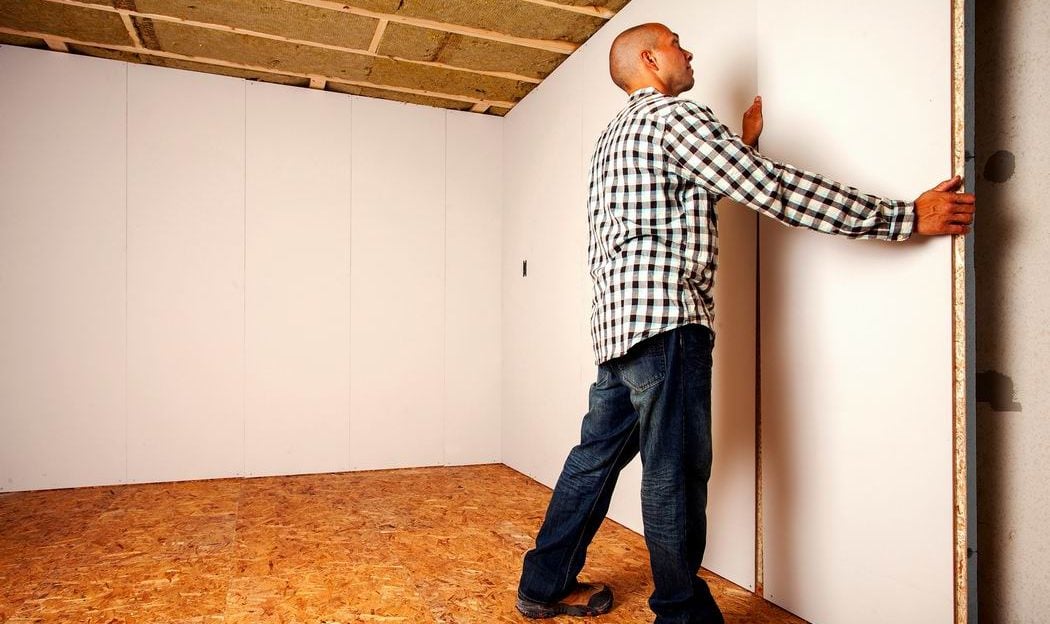With cooler weather setting in, it’s the time of year when you might be thinking it’s time to finish your basement. This is a great idea, except there’s a problem: More than half the rec room finishing jobs I see are done badly enough to cause potential health issues with indoor air quality throughout the entire house.
Here’s a true story that illustrates the point.
There’s a finished basement I know that’s both typical and dangerous. It’s in a public building that hosts different functions year-round. Other than the slightly musty smell, I didn’t think much about indoor air quality in this basement until something happened to one of my sons.
Reacting to the room
Within minutes of walking downstairs for a church service after several weeks of hot, humid weather, his eyes began running, he became congested, his throat itched and so did his ears. As word got around in the crowd about my son’s sudden allergy symptoms, half a dozen people piped up about similar reactions.
This basement has always been visibly dry, it’s bright and it looks good. The only outward sign that something is wrong is that slightly musty odour.
But basement mustiness is always just the tip of the iceberg. It invariably means there’s hidden mould growth somewhere — enough to send signals to your nose — and it’s happening in many finished residential basements because of the way they’re built.
Basements are still being finished today in ways that virtually guarantee hidden mould growth and poor indoor air quality over time.
But finish your basement following the real-world, mould-busting tips here, and you’ll be able to enjoy a cosy finished basement along with good health, too.
Tolerate no moisture
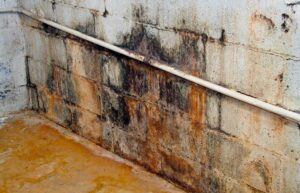
Mould will always win if there’s enough moisture. That’s why you must never finish a basement space that’s less than 100-per-cent dry all of the time. No exceptions.
It’s not just liquid moisture that will ruin your basement and air quality, but invisible moisture vapour, too. You can have a basement that’s looked dry for decades, yet you can still have a moisture problem. How do you know? Polyethylene vapour barrier plastic is your best detection tool.
Cut 24-inch by 24-inch pieces of clear polyethylene vapour barrier and tape them to the walls and concrete floor in several places. Leave them there for a few days, and look for moisture building up on the inside face.
What you see under the plastic is what will happen inside your walls after they go up. If you do see droplets of moisture (and it’s not unusual), remove the plastic, paint the bare masonry with a waterproof paint such as Drylok or Xypex, then test again. Only when your basement passes all moisture tests can you safely finish the space.
Eliminate organics
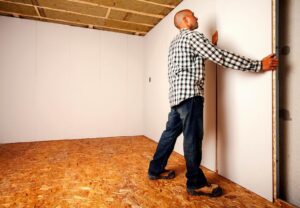
Designing basements with multiple layers of safety is always the best idea. If your basement really is always dry, there’d be no danger in using wood or paper-based drywall for finishing. But what if 100-per-cent dry turns out to be only 95 per cent of the time?
A little bit of moisture can feed a lot of mould, but it has a harder time growing without organic matter to feed on. That’s why it makes sense to keep wood and paper building materials out of the basement, or at least well away from potentially moist masonry surfaces.
This is where the still-common practice of using wooden wall studs and batt insulation in basements is foolish. It’s better to use metal studs or no studs at all.
A growing number of foam-based, stud-free building materials for basements go a long way to eliminating organics in hidden places. Just be prepared for push-back from contractors who have “always used wood studs”. I have the greatest respect for good builders, but be warned that there are a whole lot of builders out there who confuse experience with knowledge.
Use impervious insulation
Moisture can invade a basement from two directions. It can travel in through masonry walls and floors in the form of liquid or vapour, or it can come from humid air inside the basement itself. If this air makes its way into wall cavities, it can cause droplets of water to appear out of nowhere within the wall. Hidden mould is then guaranteed.
What does this have to do with basement insulation? Quite a bit.
There are two kinds of insulation: the kind that air can move through such as batts and loose fill; and insulation that air can’t move through such as high-permeability foam. The best basement insulation doesn’t allow air to move through it at all, nor does it absorb moisture in the event of a liquid leak. This is the best kind for basements.
While impervious insulation is always an excellent idea for basement walls, it’s essential where the floor joists of the level above meets outside walls along the edges of a basement ceiling. Most homes have fibre-based insulation stuffed into this place, partially covered by a feeble and pointless layer of polyethylene vapour barrier. This barrier can never work because it can’t be properly sealed around all those joists.
The only mould-resistant way to seal and insulate the rim joist area in your basement is with closed-cell spray foam. You need at least three inches to prevent hidden condensation behind the foam.
Never install carpet directly on concrete
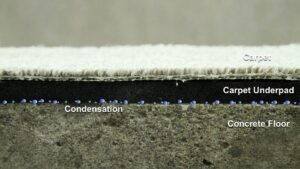
Nobody likes to walk on a hard, concrete basement floor, which is why installing carpet and underlay are such popular basement strategies. Trouble is, they can also be very powerful mould breeding grounds, especially during hot, humid weather.
If warm, outside air gets into the basement, it will settle on the floor and sneak into the carpet and underlay. Since the concrete floor underneath is always cool, it will cool the air to the point where it can’t hold all the water it used to at higher temperatures. The result is tiny droplets of condensed water forming within the pile of the carpet and the underlay. Mould loves to grow in conditions like this, and in time your carpet will smell like a wet dog.
There’s nothing wrong with installing carpet and underlay on a basement floor, but only do it on top of a raised subfloor. This eliminates any chance that warm, humid air will reach the cool concrete. A non-organic subfloor under your carpet is essential.
Ventilate only when conditions are right
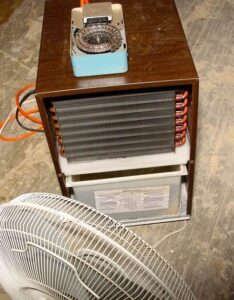
If you think ventilation is the best cure for basement dampness and moisture problems, you’d only be partially correct.
Ventilation can be a source of damaging levels of basement moisture. When it’s warm and humid outside, outdoor air transports moisture inside. As this outdoor air cools in the basement, it can’t hold as much moisture as it once did.
Go ahead and open basement windows when outdoor temperatures are cooler than basement temperatures. It will lower basement humidity levels in most cases. Just never open basement windows when it’s warmer outside than it is inside.
The only safe way to lower basement humidity levels under these conditions is with a dehumidifier or air conditioner.
If you look at newly finished basements these days, most violate some or all the mould-busting strategies you’ve learned about here. So, don’t let popularity guide you in the details of how you finish your basement. What’s commonly done today will be considered completely unacceptable tomorrow.
Bonus: Six smart rec room refinishing precautions
Got an old, previously finished rec room you’re refinishing? It’s virtually guaranteed that mould will be revealed when you tear into those old walls and floors. Follow these six mould-safe demolition tips and you’ll stay safe and eliminate mould spores that could otherwise grow back:
- Seal off the basement from the rest of the house before demolition begins.
- Buy and wear a HEPA-rated respirator before you begin demolition work. You don’t know when you’ll encounter mould.
- Remove all building material back to the foundation walls and move gutted material out from your basement to the outdoors as soon as it comes off.
- Have a dumpster or construction site trash bag waiting.
- Allow two weeks for the bare basement to dry out before you rebuild walls or floors. Ventilate well if outdoor temperatures are lower than the basement temperature. Use a dehumidifier if it’s warmer outside than it is inside.
- Use basement drying time to inspect for existing mould. Kill it with a registered, non-toxic fungicide. Use a fogger or spray equipment to get mould control products into all infested areas.
Related
Video: How to deal with mould behind basement walls
Video: How to insulate a basement with foam insulation
